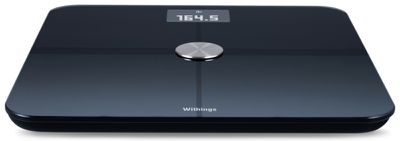Withings debuted its Smart Body Analyzer scale at CES 2013, and as of today, the scale is available for purchase.
Like its previous Wi-Fi Body Scale, Withings' Smart Body Analyzer tracks weight and body fat, but this updated version also monitors heart rate and environmental air quality.

Air quality detection might seem like a strange addition to a scale, but Withings says that the feature, which measures ambient temperature and carbon dioxide levels, is designed as a sleep and health aid.
High levels of CO2 can produce a range of adverse health effects: deterioration of sleep quality, headaches, dizziness, restlessness, difficulty breathing, increased heart rate, sweating, etc. By monitoring and managing indoor air quality, people can live and sleep in a healthier environment.
The scale, which requires four AAA batteries to function, sends the information that it collects to Withings' cloud service, which works in conjunction with the company's Health Mate app. The data can also be accessed by third party apps like RunKeeper and Fitbit.
Withings' Smart Body Analyzer is currently available from the Withings website for $149.95.






















Top Rated Comments
Also, I now just jump on the scale, wait 5 seconds, then jump in the shower. Don't have to write anything down, don't have to remember anything. I can show my doctor my weight for every day (that I am home) since Dec. 2011, which you must decide if it is worth it. It also works with others in the household, so a family of 4 can all do the same. This is well worth the cost IMO.
Next thing you know, your health insurance company is raising your pemium because you gained 5 lbs...
Ooopsss wrong thread.
----------
I agree - however if you monitor daily, the variation can be overcome by statistical methods such as moving averages (as the withings app does). Also, I get great results on my 1st gen one by measuring every morning just after getting up. I don't drink water through the night so this leaves me in a relatively predictable state. Looking at my history this gives me around +/- 1% accuracy on readings which is perfectly fine but really works best if you combine with weight to give you a fat mass reading not percentage! The moving average lets me see trend changes in a week or two (using daily readings). Bear in mind that the same accuracy caveats is true with raw weight - the contents of your digestive system will easily add +/- 1Kg to weight so I see as pretty similar accuracies and similar strategies to mitigate.
If you use it armed with some knowledge and understanding it's a great tool.